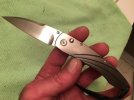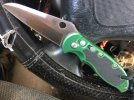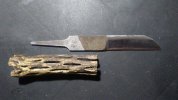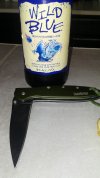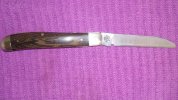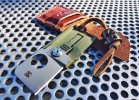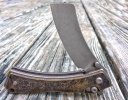- Joined
- Aug 12, 2017
- Messages
- 18
I'm relatively green in comparison to the membership here with regards to the finer details of pocket knives. This is sort of a summary of my thoughts on these two blade types and I'm looking to hear your thoughts & corrections.
At first I loved wharncliffe & sheepsfoot blades. I find most of my edc tasks don't really involve stabbing, they sort of maximize the blade for slicing tasks, string/twine/rope are easy to keep on the blade edge even when dulled, and a small bit of extra room for error before you accidentally poke yourself. Aesthetically, I like sheepsfoot/modified sheepsfoot blades. I'm somewhat indifferent to wharncliffe aesthetics, I find a decent amount of knives that have appealing overall design end up coming with wharncliffe blades so I've ended up with a few.
Then after a good while, I realized the point kinda gets in the way if you need to cut something on a flat surface but can't hold the knife parallel with the surface. I guess this is why people talk positively when describing the amount of belly a blade has? Is there some special technique I'm unaware of or is this a trade-off inherent to the blade design choice?
Are there other pros/cons out there regarding these two blade types versus drop/spear/clip point? I do still rather like "modified sheepsfoot" blades, with their slightly turned up point.
What about comparing wharncliffe to sheepsfoot? I know the difference in geometry, I'm talking about comparing use cases, advantages, etc.
At first I loved wharncliffe & sheepsfoot blades. I find most of my edc tasks don't really involve stabbing, they sort of maximize the blade for slicing tasks, string/twine/rope are easy to keep on the blade edge even when dulled, and a small bit of extra room for error before you accidentally poke yourself. Aesthetically, I like sheepsfoot/modified sheepsfoot blades. I'm somewhat indifferent to wharncliffe aesthetics, I find a decent amount of knives that have appealing overall design end up coming with wharncliffe blades so I've ended up with a few.
Then after a good while, I realized the point kinda gets in the way if you need to cut something on a flat surface but can't hold the knife parallel with the surface. I guess this is why people talk positively when describing the amount of belly a blade has? Is there some special technique I'm unaware of or is this a trade-off inherent to the blade design choice?
Are there other pros/cons out there regarding these two blade types versus drop/spear/clip point? I do still rather like "modified sheepsfoot" blades, with their slightly turned up point.
What about comparing wharncliffe to sheepsfoot? I know the difference in geometry, I'm talking about comparing use cases, advantages, etc.


